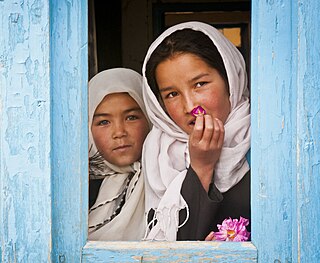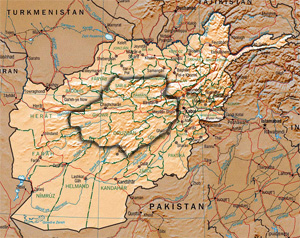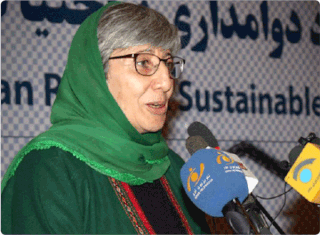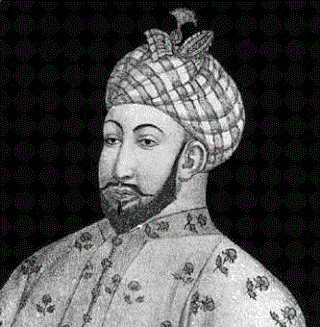Related Research Articles

The Aimaq or Chahar Aimaq, also transliterated as Aymaq, Aimagh, Aimak and Aymak, are a collection of Sunni and mostly Persian-speaking nomadic and semi-nomadic tribes. They live mostly in the central and western highlands of Afghanistan, especially in Ghor and Badghis. Aimaqs were originally known as chahar ("four") Aymaqs: Jamshidi, Aimaq Hazara, Firozkohi and Taymani. The Timuri, which is a separate tribe but is sometimes included among Aimaqs, which is known as Aimaq-e digar.

The Hazaras are an ethnic group and a principal component of the population of Afghanistan, native to, and primarily residing in, the Hazaristan region in central Afghanistan and the northern regions of the Baluchistan province in Pakistan. They are one of the largest ethnic groups in Afghanistan, and a significant minority group in Pakistan, mostly in Quetta, as well as in Iran. They speak the Dari and Hazaragi dialects of Persian. Dari is one of the two official languages in Afghanistan.

Hazaragi is an eastern dialect and variety of the Persian language that is spoken by the Hazara people, primarily in the Hazaristan (Hazarajat) region of central Afghanistan, as well as other Hazara-populated areas of Afghanistan. Hazaragi is also spoken by the Hazaras of Pakistan and Iran, and also by the Hazara diaspora living elsewhere.

The Tareen is a Pashtun tribe inhabiting southern Afghanistan, and western region of Pakistan.
The Jadoon or Jadun are a Pashtun tribe residing mostly in the Abbottabad and Haripur districts of the Hazara Division, and partly in the Swabi district of the Khyber Pakhtunkhwa province of Pakistan. The tribe is subdivided into three clans: Salar, Mansoor and Hassanzai.

Fārsīwān is a contemporary designation for Persian speakers in Afghanistan and its diaspora elsewhere. More specifically, it was originally used to refer to a distinct group of farmers in Afghanistan and urban dwellers. In Afghanistan, original Farsiwans are found predominantly in Herat and Farah provinces. They are roughly the same as the Persians of eastern Iran. The term excludes the Hazāra and Aymāq tribes, who also speak dialects of Persian.
Day Mirdad is a district in the south of Wardak Province, Afghanistan. The capital of the district is Miran city. The district used to be known as Jilga.

Afghanistan is a multiethnic and mostly tribal society. The population of the country consists of numerous ethnolinguistic groups: mainly the Pashtun, Tajik (~25%), Hazara (~10%) and Uzbek people (~10%), and minorities of Aimaq, Turkmen, Baloch, Pashai, Nuristani, Kurds, Gujjar, Arab, Brahui, Qizilbash, Pamiri, Kyrgyz, Sadat and others (~5%). Altogether they make up the Afghan people.
Behsudi or Behsud are one of the major tribes of the Hazaras in Afghanistan.
Dey Chopan, also spelled as Daichopan, is the northernmost district in Zabul province of Afghanistan. Historically the district belonged to Hazaras, which was occupied by Abdur Rahman Khan in the 19th century. In 2013, it had a population of about 38,300.
Pashtunization, also called Pathanization, is a process of cultural or linguistic change in which someone or something non-Pashtun becomes acculturated to Pashtun influence. Pashtuns are the largest ethnic group in Afghanistan and second-largest in Pakistan.
The Bache Ghulam,, is a tribe of Hazara people, largely found in Sangi Takht District of Daykundi Province, Afghanistan. They are a subtribe of the Daizangi.
The Nekpai are a Hazara tribe in Badakhshan Province, Afghanistan.
The Dai Mirdad or Dai Mirdadi (دایمیردادی) is a tribe of the Hazara people, living largely in Dara-i-Suf District, Samangan Province, Afghanistan.

Jaghori, is a major tribe of Hazara people in Afghanistan, who mostly inhabit in Jaghori District of Ghazni Province. Some Jaghori Hazaras also live in Pakistan they form the majority of the Hazaras in Quetta.
The Aimaq Hazara ; are the Aimaq's subtribe of Hazara origin, however, they are Sunni Muslims while most other Hazaras are Shia Muslims. Some of the Aimaq Hazara and Timuri are semi-nomadic and live in yurts covered with felt.

The Hazāra of Muḥammad Khwāja is one of the major tribes of the ethnic Hazara inhabiting Afghanistan.

The 1888–1893 Hazara uprisings or massacre and displacement of Hazaras occurred in the aftermath of the Second Anglo-Afghan War when the Afghan Emirate signed the Treaty of Gandamak. Afghan Amir Abdur Rahman Khan set out to bring the Turkistan, Hazaristan, and Kafiristan regions under his control. He launched several campaigns in the Hazarajat due to resistance to oppression from the Hazaras, culminating in the Battle of Uruzgan and he conducted a widespread campaign against its population.
References
- ↑ Mousavi, Sayed Askar (1998). The Hazaras of Afghanistan : an historical, cultural, economic and political study. Richmond, Surrey : Curzon. p. 140. ISBN 0-7007-0630-5.
- ↑ The Hazaras of Afghanistan and their Shi'a Orientation: An Analytical Historical Survey. ICAS press. 2014. pp. 153–154.